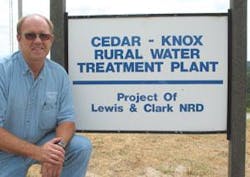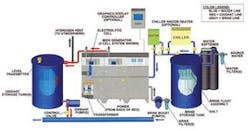On-Site Disinfection System Provides DBP Reduction, Residual Maintenance
By Gene Schroeder
The Cedar Knox Rural Water Project, in Northern Cedar and Knox, NE, needed to reduce the formation of Total Trihalomethanes (TTHMs) while maintaining a chlorine residual at the farthest reaches of the distribution system. The water project serves four communities and 721 hookups with a total of 3,200 customers in northeast Nebraska. The source for drinking water is the Lewis and Clark Lake, fed by the Missouri and Niobrara Rivers. Average winter flow is 300,000 gpd with flows peaking at 750,000 gpd in the summer.
Cedar Knox traditionally treated the water with 150-pound chlorine gas cylinders, using a maximum of about 25 pounds per day of chlorine. The disinfectant is injected prior to the clearwell and has about 6 to 8 hours of detention time before going out to distribution. The distribution system covers 360 miles of pipelines with the longest reach being 43 miles from the treatment plant. The water frequently has a 6-7 week detention time in winter with an additional 3-4 weeks of detention in the village of Obert, NE, which is the farthest customer from the plant.
With use of gas chlorine, the Cedar Knox RWP would have occasional TTHM excursions over the previous limit of 100 parts per billion (ppb). With the reduced limit of 80 ppb impending, the utility needed an effective solution to TTHMs in the distribution system. In addition, the typical gas chlorine dosage to maintain a point of entry reading of around 3 mg/L was not sufficient to sustain the old requirement for a 0.02 mg/L residual at the longest residence point. Cedar Knox would occasionally approach EPA’s maximum chlorine dosage of 4 mg/L in an attempt to maintain the required residual at the end of the line, to no avail. As the chlorine dose increased, TTHMs would further increase, adding to the already existing problem.
Cedar Knox began investigating solutions. Personnel read about on-site mixed-oxidant technology in an industry journal, and discussed on-site generation with colleagues in a neighboring state also considering a conversion from chlorine gas. The water project decided to purchase the on-site mixed-oxidant equipment in June 2000. The system operates using salt, water and power, converting a brine solution into chlorine-based mixed oxidants via two electrolytic cells, each with a 25 pound per day capacity. Each cell has its own dedicated power supply, brine pump, and control panel, providing complete operational redundancy to meet daily chlorine requirements.
After first installing the system, even though levels of iron and manganese in the water were low, the utility experienced more maintenance than expected due to iron and manganese fouling of the cells. The electrolytic cells had to be acid-washed every 2-3 weeks (every 163-220 hours of operation) and the system brine filters changed out every 4-5 weeks. Operators were spending 1/3 hour weekly on maintenance of their new system versus 1/2 hour every six months on the previous chlorine gas system.
On the recommendation of the manufacturer, the utility now adds one bag of “Red Out” citric acid for every 10 bags of salt, resulting in much less contamination. Maintenance has improved measurably, with the cells only having to be acid-washed every 8-10 months (1200 hours of operation) while filter replacement is only required every 12 months. Maintenance requirements have dropped to less than 1/2 hour per month.
The utility was able to make these changes for an installation cost of approximately $75,000. Salt and electric cost for the mixed-oxidant equipment is running at 3.4 cents per 1,000 gallons of water treated, with maintenance costs of $450 per year. The total flow last year was 130,346,000 gallons, equating to a total annual cost of operations of $4,882 ([130,346,000 gallons * $0.034 / 1,000 gallons] + $450).
The estimated operations cost for gas chlorine is slightly higher at 3.9 cents per 1,000 gallons of water treated, with estimated maintenance costs of $50 per year. The total annual cost with chlorine gas would have been $5,133 ([130,346,000 gallons * $0.039/1,000 gallons] + $50). With on-site generation, the utility is saving approximately $250 per year.
More importantly, the water project has drastically reduced TTHMs and is now in compliance with the new required 0.2 mg/L chlorine residual at all points in distribution. After running the on-site mixed-oxidant pilot system for a month, TTHMs measured 50.2 ppb, the lowest measurement since 1993. A temporary conversion back to chlorine resulted in an immediate increase in TTHMs, up to 108 ppb. Since permanent installation and operation of the equipment in August 2000, TTHMs have been consistently 30% to 50% less than when using chlorine gas, with current values around 74.5 ppb.
To bring the utility comfortably into compliance with the 80 ppb limit, carbon treatment is being added prior to clarification, which will reduce disinfection by-product precursors, further reducing formation of TTHMs in the treated water. Pilot test trials with powdered activated carbon gave evidence of another 30% reduction in TTHMs beyond what mixed oxidants alone were able to accomplish, bringing Cedar Knox comfortably within the limit at 50 to 55 ppb.
After several months of operation with mixed oxidants, Cedar Knox also discovered that the chlorine residual was now lasting to the farthest reaches of the distribution system. In fact, the utility was able to reduce the chlorine dose by 30% to 50%. With a residual of only 1.8 to 2 mg/L leaving the plant, in contrast to the previous dose of 3 to 3.6 mg/L, a stable and durable chlorine residual of about 0.4 mg/L is maintained at all points in distribution. This residual lasts 6-7 weeks to the farthest point in distribution, and lasts an additional 3-4 weeks of detention in the distribution system of the Village of Obert.
Being able to use a lower dose also helps the utility with TTHM formation since there is less chlorine to react with organic material in the water. The utility attributes the longer-lasting residual to the mixed-oxidant disinfectant removing biofilm in distribution pipelines, thus enabling the chlorine to endure without being consumed by the oxidant demand of biogrowth.
About the Author:
Gene Schroeder is Manager for the Cedar Knox Rural Water Project. He has been an employee with the project since September 1992. He originally started as the plant operator and in July 1999 became the District’s manager. Schroeder is a Nebraska Licensed Grade I Water Operator for the system. He also currently serves on the Nebraska Rural Water Association Board.



